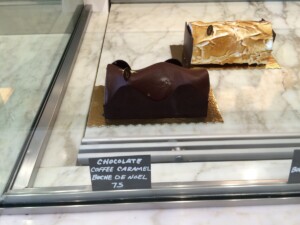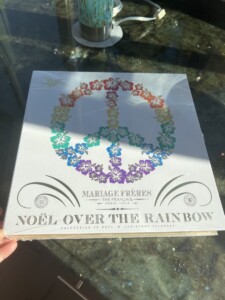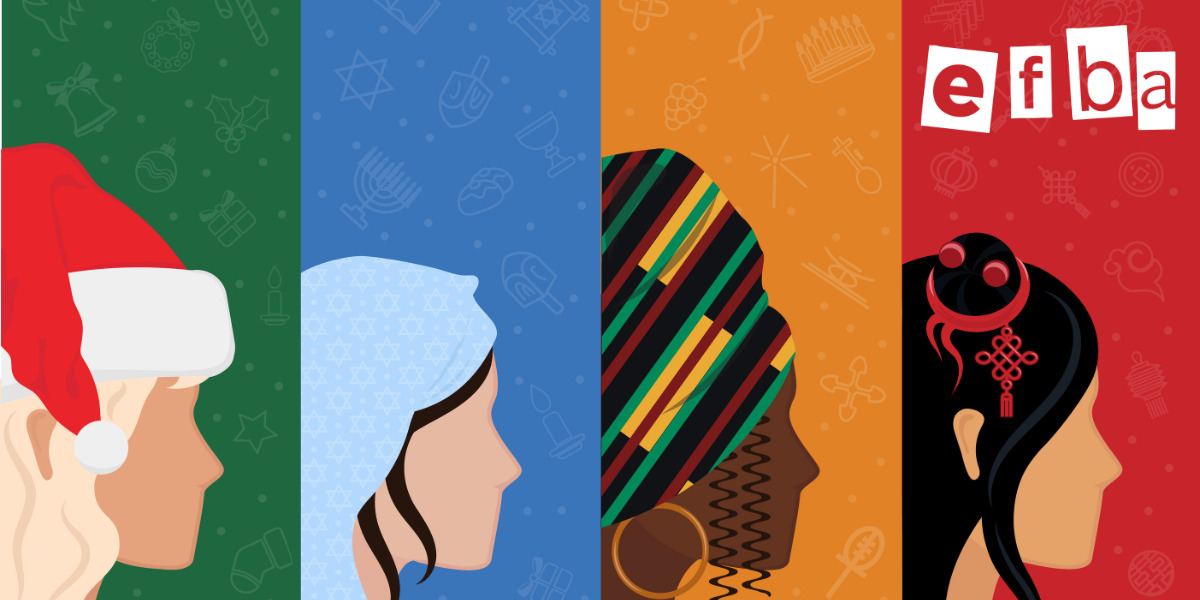By Gabrielle Durana, EFBA President
For kids, it’s a morning full of magic and excitement. For adults, the unyielding pressure to get every detail just right. The holiday season is one that lends itself particularly well to nostalgia as well as regrets. Decorations, traditions, family meals, gifts, everything comes together to bring that shared December-early January day-dream to life.
When you live abroad, the holiday season is even more important. For the more fortunate, it means a trip, a holiday to the “home country”, a return to the chaos of family gatherings in the old family house. The kids will make new memories out of it all. For everyone else, family pressure is relative to the distance from home and “when you can’t make it back (more than) once a year,” holiday festivities escalate, mixing with symbolism and identity.

b. pâtisserie – San Francisco (2016)
There is much to say about the commercial aspects of end of the year celebrations and how we’ve taken to compensating for the absence of human beings with an explosion in consumption (excessive quantities of food, decorations, gifts, and all the rest). These aspects of ostentatious pomp are fairly well known and ultimately change in extent, rather than nature, when you live abroad. You would never pay 75 euros for a buche de Noël in Paris (see image), for example, but you might just crack when you see it in San Francisco. You could always learn to make it for yourself, too (see the recipe below). Likewise, an Advent Calendar (see image) that, since you aren’t religious, never meant much for you before might suddenly take you back to your college days in Saint-Germain des Prés, when you had to count every cent you spent to make sure you still had enough left over to pay for books. Then, with a self-assured smile about how your social situation has changed, you order your madeleine de Noël. Not to worry, FedEx will get it to you shortly!

Advent Calendar
In this article, I would like to focus on two parts people usually don’t talk about. First off, I want to discuss the gap between how the majority of people in the new country celebrate–or don’t–end of the year festivities and “our” traditions, the kind of unease that that can create for individuals and families and how you can get through it. Then, I’ll look at how we can make use of this almost inevitable gap to move kids beyond our own specific ethnic “traditions” and introduce them to the universality of rights of passage while imparting onto them an appreciation of cultural diversity.
Many of the examples here are drawn from my own experiences. I grew up in Evry, a city near Paris, part of an atheist, Italo-Argentine family immersed in Judeo-Christian culture. When I was a student, I lived in Paris, Ireland, Morocco, and Spain. As an adult, I live in San Francisco with a non-practicing Muslim of Bengali heritage. The examples I’ve chosen serve only to demonstrate my point, nothing more.
When the dominant culture of the country goes against your traditions or makes them invisible

I’m four years old, and I’m living in Buenos Aires. I’m on my way to visit my grandmother in her apartment building. Just like in the Anne Sylvestre song, the elevators had broken down and, to get to her floor, I have to climb a staircase that hurts my feet. The next morning, I come back and boom, miracle–the elevator works again! “The Three Wise Men came to repair it during the night,” my grandmother explains to me. From that day on, all I wanted was for that elevator to break down again so that I could catch a glimpse of these Three Wise Men.
When I arrived in France at the age of six, the Three Wise Men were strangers to the rest of the kids. To encourage us to stay calm, the teacher would tell us that the Père Noël would bring presents to all the good girls and boys. My parents were restarting their life from scratch and didn’t have any money. One night, they called me to their room to tell me that great grown-up truth. The pain of not receiving any presents passed quickly. In reality, I had already had to mourn a much more painful loss: despite my delightful memories, the Père Noël was the only mythological figure who was “persona grata” during the holidays in France.
My parents tried their best to maintain the traditions around the Three Wise Men, but the gap between celebrating Christmas at the end of December and celebrating the Kings at Epiphany made the wait all the more unbearable. And then, on top of that, the Wise Men were imposters. Long dead in my mind, they could no longer be mentioned in our house. I wanted a Christmas tree and, thankfully, my parents quickly gave in without much cultural or religious resistance. In France, Christmas was officially a secular holiday so they could accommodate it within their own atheist beliefs.

Hanukkah and Christmas wreathes set side-by-side, as seen hanging on the door at the home of EFBA’s communications manager, Alex Nichol.
I hadn’t thought twice about the matter with the Christmas tree until, one day in San Francisco, a collector in the art gallery I was working in at the time, before founding EFBA, started telling me about how when he was a kid, his Jewish parents had refused to allow him and his sister the sacrilegious tree. The end result? Despite having married a Jewish woman, he’s incorporated the Christmas tree in their family traditions right alongside the menorah. The official reason was to please the progeny, but could also it perhaps be to right his own childhood wrong?
Even if my parents had adjusted the family festivities to adapt to mainstream French culture, they had a much harder time giving in when it came to food. The holidays always bring with them traditional dishes and delicacies. I remember just how excited my mom was when she had found some panettone, not at Fauchon, the French Bergdorf Goodman, but in a humble supermarket over in our Epinettes neighborhood in Evry. She cut me an enormous slice. I tasted it, and promptly decided that I hated candied fruit. Still, I wanted to make her happy. Over the years, my parents continued to celebrate Christmas and the end of the year with panettone because it was important for them, even as they supplemented it with Picard’s frozen bûches, which us kids actually enjoyed. I’m sure that my mom saw how indifferent I was to her culinary traditions and felt sad about it. These days, I like panettone because the taste reminds me of maman.
This patchwork between family traditions and those of the host country creates cultural syncretism. The term syncretism comes from religious sociology, but for our purposes, we use it to describe the result of a hybridization, of a “bris-collage,” which leads to the formation of a “third culture” of celebrations and traditions.
This synthesis is the result of the clash and the influence of beliefs, values, and traditions of opposing cultural systems. It’s the result of a compromise in the balance between adult power in the family unit and the influence of the surrounding society, especially school, media, and friend groups.
For some, this syncretism is stigmatized as contamination by outside influences, while for others, it is hailed as a creative synthesis (Mary, 2010). Driven by pragmatism (family life needs its routines and rituals), the end result is an aggiornamento, literally an “update” that, though forced, is welcomed into the religions and traditions held by the family. This holiday equivalent to “Vatican II” allows for the restoration of familial harmony.
From syncretism to appreciation of others’ culture

There comes a moment in one’s life when we realize that the “waking dream” of the holidays isn’t necessarily a “shared dream”, that is to say, that it doesn’t include everyone, that certain people don’t celebrate what “everyone celebrates” and above all that the people living around us have other holidays, too. For me, that moment came in Evry, when we were kids. One day, my brother came back from an errand, rolling on the floor laughing. In France, stores are closed on Sunday afternoons. My dad had sent him to buy some soda from “l’Arabe du coin” or, as they say in Québec, from the “dépanneur, i.e. the convenience store often owned by people of North African descent. My brother could not stop laughing as he told us the story. He had found the doors closed, with a message on the window reading “Closed for Eid.” I remember just how amazed we were. How could it be that someone whose main selling point was being open all the time–that was what justified the higher prices–be closed? The unusual nature of the situation should have made it clear that the holiday in question, completely unknown to us, must have been incredibly important to them. But to the point of closing their store? My brother and I couldn’t believe it!
The fact that our parents didn’t take the time to tell us about the holiday and what it entailed was a missed opportunity for our general knowledge about the world. It can be partially explained by their deep-rooted anti-clericalism. A Christmas tree, sure, but midnight mass? That would have been out of the question. Long live secularism! It’s a good thing we lived in the Parisian suburbs where St. Nicolas parade wasn’t a common feature of public spaces.
What we had actually felt that day was less the sentiment that the holiday unknown to us was a “fake holiday” and more that it was a true celebration : one for which the owner was willing to sacrifice even his profits.
So, how do you move beyond the ignorance of adults who aren’t theologians of all the world’s religions? How do you make use of the inevitable gap to move kids beyond our own ethnically centric “traditions” and introduce them to the universality of rights of passage while imparting onto them an appreciation of cultural diversity?
The first thing we can do is change our own perspective as adults and try to be curious. Whether you’re a parent or an educator, imagine the impact it would have on kids if, instead of saying “Countdown to Christmas: Discover 25 Other Ways of Celebrating Christmas in the World” we built our educational moment around a journey through “25 End of the Year Traditions from Around the World”? It would be like rewiring their whole world view.
Appreciating the diversity of traditions that all culminate in an end-of-the-year ritual does not threaten our identity in the slightest. Just as you can speak multiple languages and be integrated in society, you can also be interested in others’ traditions while maintaining your own familial syncretism.
You wouldn’t be required to adopt traditions that don’t strike a chord with you, but you would bear goodwill towards them, instead of just tolerating them. When it comes down to it, what would happen if we taught kids that Eid-el-Kabir is a kind of “moving” Christmas (moving because of the lunar calendar) for Muslims? It wouldn’t be exactly accurate from a religious perspective, but wouldn’t it also stop sending the signal that their holiday is anything less and they should have to cancel it to come take part in our society?
In California, we hear people talk about Hanukkah, Kwanzaa, Christmas of course, but also about the Winter Solstice. Kids might not know all of these traditions but they have their place in society in the name of pluralism (see this photo of the center of Union Square in San Francisco, where a giant Hanukkah menorah shares the place of honor alongside the Christmas tree). You start naming them, one by one, and over time, you come to know them. Then, you can head home to prepare your bûche and your gingerbread house.
Text written in French by Gabrielle Durana
Translated by Zach Sebree
Recipe: Homemade bûche de Noël
Ingredients:
4 egg yolks
75g or ⅜ cup sugar
50g or ⅖ cup flour
50g or ¼ cup + 3 tbsp starch
4 eggs whites + 25g or ¼ cup sugar
Preparation:
- Whip 4 yolk, sprinkling in sugar until it thickens
- Quickly mix in the egg whites and 25g sugar and whip to a soft peak, then add in the flour and the starch
- Spread on a sheet of parchment paper and cook for 8 to 10 min at 400F (200C)
- Once taken out of the oven, place the cake (with the parchment paper) on a cold surface
- Cover it with nutella and then a bit of blackberry jam
- Roll it up
- Cover with homemade whipped cream
- Let sit in the fridge to be served with the next meal
Bon appetit !

